TALL CLASS XIII – California
(Photos by Lindsay Kennedy)
Monday – October 14, 2013
CALIFORNIA – Sacramento
This California trip was simply amazing. We spent all our time on farms and in ag related plants. When I started the TALL journey one of my first trips was to the Amarillo/Lubbock farms. These farms are incredible – huge – awesome. Many of my TALL classmates are the farmers – the stewards of the land. I left in awe. Arriving on some of the California farms, we were all struck by the magnitude of these farming operations – #1 in US farm production – #1 in ag exports – #1 dairy state – 400 plus commodities – 50% of the Nation’s vegetables, fruits, and nuts – $400 billion of the State’s economy depends on it’s farms. I have to say – I really knew nothing of this since the only media take we get is about their broken economy – their over regulation – their persona of tree huggers and PETA zealots. It was eye opening. COMPLICATED – is an understatement.
Mr. Paul Wenger – President, California Farm Bureau Federation
California Agricultural Policy Briefing
Mr. Wenger’s family is in tree business – almonds and walnuts. His family has been here 103 years. California is a specialty crop state. California production is a combination of Texas and Iowa production – by far and away #1. State is geographically diverse – deserts – rich farm land. One farm model does not fit all. Production different throughout the state. 43 ½ billion in ag production – ag is the driving force in California.
Ms. Cynthia Cory – Director, Environmental Affairs, California Farm Bureau Federation
Air quality is big issue. Around 2005 air quality regulations kicked in for agriculture. Ag equipment and trucks have to be a 2010 engine to comply with air quality – must be in effect by 2023. If you are coming in from another state and you are not compliant – you will be turned away. This is really a hard hit to the producer economically.
Climate change another big issue. Looking at water use – nitrates – greenhouse gases.
All the regulations are putting people out of business. Texas still has some reasonableness – not California. Bottom line question – do we feed the world? If that is our mission, then we have to back off some of these crippling regulations. Very concerned about the impact of over regulation.
Secretary Karen Ross – Secretary of the California Department of Food and Agriculture 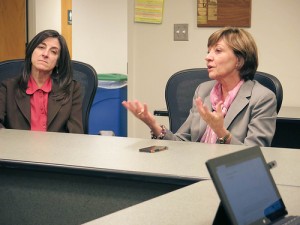
The California Secretary is appointed – not elected. She still owns a farm in Nebraska. Now California is her work – farming not easy in California. Big issues – invasive species – animal disease – again that chilling word………..over regulation. With budget cuts – need effective safety nets – critters don’t stop because of money issues. Other issues – water – labor. They are challenged to work across cabinet – won’t be additional funds – must be able to make informed decisions with strains on budget. 400 crops – micro climates. Very fast growing dairy industry but California does their own pricing – no opt outs as in Federal system which has led to many dairy farmers leaving California.
Tree nuts currently high demand – growth is incredible.
Marijuana is a problem – not complying with any regulations – stealing water – heavily armed – growing on Federal lands – using pesticides not allowed on other farms. Initially for medical reasons – now – out of control. But it does seem legalization is the future.
Water – status quo not sustainable. Capture is through heavy rains that fall in Northern California. Southern California – farms – biggest users. 2/3’s of California’s rain is in the North while 2/3’s of California’s people are in the arid South. Have to work with local – regional communities for storage – recharge. Desalination now being looked at.
Farmers are all about adaptation – but the big issue – the people making regulations don’t really have a working knowledge of farms.
Mr. Justin Oldfield – Vice President, Government Relations, California Cattlemen’s Association
 Very vibrant cattle industry in California – 7% of the Nation’s livestock revenue. The Association was formed in 1917. California largest ag state in US. $2.83 billion in cash receipts annually in beef cattle. 620,000 beef cows statewide. 5.3 million cattle in California. Dairy and beef make California 2nd largest livestock state. California largest dairy state. Issues have dairyman leaving – now fallen to #2.
Very vibrant cattle industry in California – 7% of the Nation’s livestock revenue. The Association was formed in 1917. California largest ag state in US. $2.83 billion in cash receipts annually in beef cattle. 620,000 beef cows statewide. 5.3 million cattle in California. Dairy and beef make California 2nd largest livestock state. California largest dairy state. Issues have dairyman leaving – now fallen to #2.
Cow-calf producers – stocker/background yards – cattle feeders – and packers make up the cattle industry. (1) Cow-calf operation – maintain cow breeding herds – pasture based. (2) Stocker/background yard – purchases calves to raise to 700-900 lbs. largely annual yearling operati8ons for both steers and heifers. Pasture and feedlot based. Tuprotein (grain) ration. (3)Packer – purchase and harvest cattle at 1300 lbs. 2 large beef packers left in California.
Ranchers own or manage 34 million acres. Almost all surface waters cross public and private rangeland. Makes the ranches a target for issues. 53% of California federally owned.
Challenges impacting California beef producers – business and input costs – regulatory impacts – cattle markets – consumer confidence – land use – future generational interest and opportunity. Land use is converting to tree nuts and vineyards.
Williamson Act – enroll in ten year contract with state and county that one will stay in agriculture so they are only taxed on what they produce.
Labor is critical issue. Not as many Mexicans coming because a lot of farms moved into Northern Mexico so they can get jobs in Mexico.
Tuesday October 15, 2013
We were met early by Ara Azhderian and Jason Peltier. They were the experts and our tour guides for the San Luis Delta Mendota Water Authority and the Westlands Water District.
Mr. Jason Peltier – Chief Deputy General Manager, Westlands Water District 
85% of water in Delta comes from Sacramento River. Freeport – no tax to park your boat during gold rush days. 700,000 acres in the Delta. This is an inverted Delta – very unusual. The Delta is broken – fish are endangered. In the old days it was hydrology – today it is regulation. 1000 miles of levees. When the water receded – islands formed and land was reclaimed. In parts – land is below sea level – that is a problem. Levees are subject to failure because they were not engineered – built by Chinese labor – pulled sand and silt out of river to form the levee. Major crops in the Delta – grapes for wine – Bartlett pears – cherries. In Napa temperature swings from 90 in day to 60 at night – that gives the wine characteristics.
The Delta breeze – every night. Construction of dams keeps water fresh and salt water out.
Fresh Water from the Delta supports: 25 million Californians and 3 million acres of agriculture. $400 billion of the State’s economy annually. Any loss impacts our economy and environment. Water rationing in the San Joaquin Valley idled half a million acres of once productive land laying off masses of farmhands.
Stressors on the Delta: toxic pollutants – upstream diversions – In Delta diversions – invasive species – predation – climate change – recreation and commercial activities – intentional take – ocean conditions – water quality – food supply – stock recruitment. Endangered species act: Delta smelt – Chinook salmon – Steelhead – Sacramento Splittail and Green Sturgeon. Of course seismic events in the Delta region would create mass destruction and the thought of such events are an ever concern.
Holt Tractor (Caterpillar) started here – invented the “crawler” to work the peat soil in the Delta.
Stockton – Central part of the Delta – not as many trees – no levees but cement brick walls. Port of Stockton is very viable. Rice is exported. More ag out of Port of Oakland.
There is a water market but the market is not used because they can’t get the water through the Delta. When rice prices are in the tank – they can fallow the land and sell their water to the cities. $150 an acre foot up to $800 an acre foot. A big challenge for almond farmers is post harvest irrigation to set the crop for next year. Bankers want to see water plans – project water – ground water – crops being produced.
Literally 1000’s of wind turbines in the mountains.
 We toured the Jones Pumping Plant and Tracy Fish Facility. It was an amazing engineering feat. This pumping plant controls Delta outflow – upstream consumptive use – In-Delta consumptive use and exports. Any water loss impacts the California economy and environment. The most obvious observation is that California is decades ahead of any other State in water planning – waterway development – water distribution.
We toured the Jones Pumping Plant and Tracy Fish Facility. It was an amazing engineering feat. This pumping plant controls Delta outflow – upstream consumptive use – In-Delta consumptive use and exports. Any water loss impacts the California economy and environment. The most obvious observation is that California is decades ahead of any other State in water planning – waterway development – water distribution.
Next we toured the Ingomar Packing Facility where they make tomato paste and diced tomatoes. They believe their success is in selecting the correct tomato varieties, good farming practices and controlled processing. They have two processing facilities in Los Banos, California. Ingomar Packing Company is 100% grower owned – focused on the finest quality tomato products for their customers. Most of the tomatoes that make up their products are grown on their owners San Joaquin Valley land – Bennett Farms, Del-Mar Farms and Vaquero Farms.
Next we were treated to lunch at the famous Woolgrowers Restaurant in Los Banos, California. There Mr. Mike Wade – Executive Director, California Farm Water Coalition briefed us on California Water Issues. Mr. Wade’s family is in the almond farming business in Merced County. So much information – a factual look at how and why farmers use the water they do to grow our food, fiber and nursery products. Today’s vast improvements in productivity and efficiency would not be possible without a highly developed water supply system. The California Farm Water Coalition is a non-profit – educational organization committed to providing fact-based information relating to the use of farm water to the people of California. They represent 5.6 million irrigated acres in California. What a novel idea – facts!! The water issue is so complicated and we are all going to have to work together to resolve our differences – but we must speak to the facts. Here again we see the disconnect that most people have with their food supply and a lack of understanding and truth about the use of water for our farms. The Coalition maintains a website at www.farmwater.org and is the only statewide organization dedicated solely to farm water issues. Check it out!!
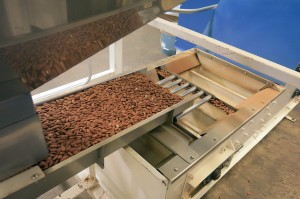 Next stop – RPAC custom almond hulling and processing plant in Los Banos, California. This facility handles the almond from harvest to shipping. They handle trucking, stockpiling, and storage. They not only facilitate the growers in the processing but they provide marketing alternatives. Very few people are working these facilities because of the electronic sizing, cleaning, and sorting equipment. Of course, they hold themselves to a high standard of food safety and quality so every lot must pass a visual inspection of their hand grading team. I always find it fascinating to see the technology at work discarding sticks collected in harvest –the removing of the protective hull – then the shell. Then the whole natural almonds are sized and cleaned. Almonds are in high demand – snack foods, baked goods, candies. RPAC stands ready to meet their buyers demands for quality almonds.
Next stop – RPAC custom almond hulling and processing plant in Los Banos, California. This facility handles the almond from harvest to shipping. They handle trucking, stockpiling, and storage. They not only facilitate the growers in the processing but they provide marketing alternatives. Very few people are working these facilities because of the electronic sizing, cleaning, and sorting equipment. Of course, they hold themselves to a high standard of food safety and quality so every lot must pass a visual inspection of their hand grading team. I always find it fascinating to see the technology at work discarding sticks collected in harvest –the removing of the protective hull – then the shell. Then the whole natural almonds are sized and cleaned. Almonds are in high demand – snack foods, baked goods, candies. RPAC stands ready to meet their buyers demands for quality almonds.
Our last stop for the evening was Monterey, California where I enjoyed a lovely dinner with friends/classmates at the Fishermen’s Wharf. Our journey took us down Highway 198 – magnificent – awesome!!
Wednesday – October 16, 2013
This morning we were met by Ms. Nye Hardy – Senior Food Safety Manager for Dole Fresh Vegetables. She started out by telling us that “those who play in the dirt – can’t be in the plant”. It is all about food safety. When I was finished with this tour, I decided I would never buy anything but Dole leafy greens. We were taken to one of their lettuce fields. Rows and rows of different varieties of lettuce. One row was planted with 4 different kinds of lettuce so that when it is harvested, it is ready to go into the bag. Incredible!! Every precaution was taken in the field for consumer safety – hairnets – beard nets – gloves – no jewelry. Food safety is a culture and every worker in that field took a great deal of pride in their work. They wanted to do a professional job – and they were delivering. Nye explained that the culture requires constant education and shared behaviors. The point is to keep the bacteria out – the point is not to test for bacteria because you can’t test your way out of the problem. It must be preventive. Food is tested in the field. If 3 pathogens are found – the field is plowed under. Wild life can’t be controlled – migratory birds will stop in the fields – hogs – deer – raccoons. Dole will kick out 10 to 15 acres a week – but 1800 acres will be harvested. When there is lots of rain or high temperatures – tests will be increased. The complicated issues are the farms adjacent to each other – not all use the same pesticides or no pesticides – organic vs. natural – one set of food safety standards to minimum standards. Lettuce is never planted near cattle pastures. In fact, we saw few farms adjacent to any animal farms.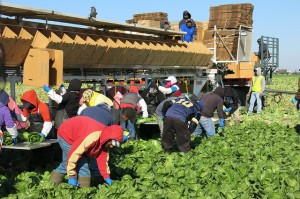
We went from the farm to the Dole Fresh Vegetables Value-Added Plant. Lettuce was washed – chopped – shredded – mixed – bagged – boxed – made ready for shipment.
Our next stop was Creekside Farms in Greenfield, California. This remarkable place produces natural artisanal wreaths and garlands. From the time we walked in, the smell of lavender – herbs – flowers – dried fruits was heavy in the air. They grow their own plants for their wreaths. It all started when the owner helped a friend make wreaths – her special touch was adding California pepper berry. Now these beautiful wreaths are sold all over the world.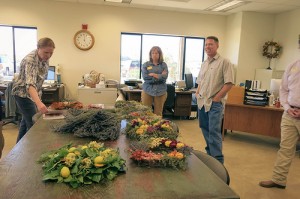
Scheid Vineyards started in 1972 in Monterey County when Al Scheid purchased his first piece of land. Now they own ten estate vineyards located along a 70 mile spread of the Salinas Valley – approximately 4200 acres of vineyards. We toured their state of the art winery that has a crushing capacity of 30,000 tons. They also have a small Reserve Winery where the small production wines of Scheid Vineyards are crafted. Their first plantings were heavy in Colombard, Chenin Blanc and Ruby Cabernet – but they have expanded due to the market demanding Chardonnay, Cabernet Sauvignon and Merlot. It is still a family run business even though they took the company public. They are passionate about growing grapes and crafting award winning wines.
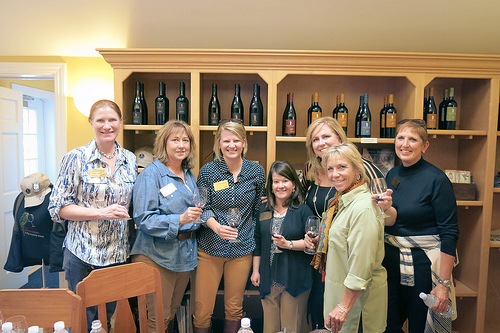 Our last stop for the evening was the Harris Ranch Resort and Restaurant located in Coalinga, California. Our evening was sponsored by the California Cotton Ginners and Growers Association and we were privileged to have their President and CEO – Mr. Earl Williams speak to us. Also Mr. Don Cameron – Vice President and General Manager of Terranova Ranch was there to welcome us. The US produces 38% of the world’s cotton. California used to have over 1 million acres in production – now 190,000 acres. The land is going into production for products yielding higher revenues – for example: almonds are in high demand presently. But California is now planting more PIMA cotton. PIMA cotton is the highest grade cotton available. Cotton is bringing on the average around 80 cents a pound. One California grower has carved out a market with an Italian shirt maker who pays him $500 a pound for his PIMA cotton. The Cotton Growers Association works on many issues – minimum wage – water quality – replacement of diesel fired pump engines – environmental issues – alternative fuels – disease and pest controls. They have done a phenomenal job of marketing – securing many licensing agreements: Macy’s, Dillards, Nordstroms, Saks – just to name a few of my old haunts.
Our last stop for the evening was the Harris Ranch Resort and Restaurant located in Coalinga, California. Our evening was sponsored by the California Cotton Ginners and Growers Association and we were privileged to have their President and CEO – Mr. Earl Williams speak to us. Also Mr. Don Cameron – Vice President and General Manager of Terranova Ranch was there to welcome us. The US produces 38% of the world’s cotton. California used to have over 1 million acres in production – now 190,000 acres. The land is going into production for products yielding higher revenues – for example: almonds are in high demand presently. But California is now planting more PIMA cotton. PIMA cotton is the highest grade cotton available. Cotton is bringing on the average around 80 cents a pound. One California grower has carved out a market with an Italian shirt maker who pays him $500 a pound for his PIMA cotton. The Cotton Growers Association works on many issues – minimum wage – water quality – replacement of diesel fired pump engines – environmental issues – alternative fuels – disease and pest controls. They have done a phenomenal job of marketing – securing many licensing agreements: Macy’s, Dillards, Nordstroms, Saks – just to name a few of my old haunts.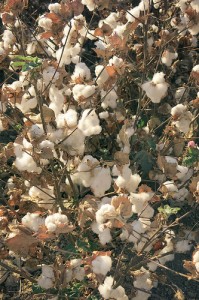
Thursday – October 17, 2013
Mr. John Diener – President Red Rock Ranch, Inc
Westside Salinity Issues Briefing
Demands on water are changing. Attitudes toward agriculture create an adversarial environment. We are all involved in politics. 60 miles of the ocean in California – 70% of the votes. Not much will happen if ag does not have the votes. Because of term limits – whole new group of politicians without any knowledge of ag – no expertise – have been elected to office. Bureaucracy feeds on itself – gets bigger. Farmers are very concerned about this lack of understanding because the current conditions are very dry – and they may not get the water they need next year for their crops.
Dynamics have changed – population increased – coastal areas put in water permits. Who drives the city council – the unions and the developers. So they started building in the valley.
They have the money and they drive local elections. Now the water coming through the Delta gets filtered through the city. Water softners have salt and now that is being introduced into the water. Salt does not bode well for farming. 60% of water degradation came from the water softners.
Water meters were put on houses. Water usage went down 40% because people became aware of their water usage.
Desalination is the next step in water development for California. The issue is the cost of the process. It takes a great deal of power to run the plant.
We next began a tour. Our first stop was the Harris Ranch Feedyard – over 100,000 head of cattle. About a month ago – someone set explosives on 12 trucks and blew up the trucks waiting to go into the yard. It appears to be an assault from some animal rights group. No one has been charged. The attack received no national media coverage. 
We saw vineyards – cotton fields – citrus orchards. Remember the “Cuties” that took all the groceries by storm – no one could get enough. Well, we saw those beautiful trees. We walked through orchards of orange trees. Oranges – cool for color. Heat for sweetness. Coolness won’t allow many parasites.
US uses 300 milllion cases of wine a year. Now Japan is requesting our wine. $900 a container to ship to Asia. $15000 an acre to develop a vineyard. Every country has water problems. San Joaquin Valley is the answer to projected growth. Fueling world demand for wine.
Some of the vineyards are over 100 years old. Many kinds of grapes – wine and raisins. Raisin – managed system of marketing from the 30’s – stable but bargained for and maintained by government. Arbor system. Farms are like portfolio management – diversification – spread risk – cost of equipment – have an idea of the price you will receive for your product. Owl boxes – owls are predator control for gophers. Grapes are harvested at night – need to be kept cool. Machines shake vines – grapes put into tanks.
Almond hulls fed to cattle. Problems with ants – when you harvest – can’t spray – needs about 10 days to dry. Trying to achieve 3000 lbs per acre which needs 4 acre feet of water. Water well should be a back up – not the initial source of water. Almond trees are very sensitive to water stress – defoliation affects next years harvest. $3500 an acre to grow product. Bees cost about $400 an acre. 60 to 70% of hives come here from all over US – then they return to their original homes.
Molds of any kind will knock you out of compliance at the factory
Bee hives are brought in for pollination. Bees are moved around to different areas for different crops. Very interesting. They don’t want cross pollination. The citrus growers don’t want the bees because it will put the seeds back into fruits that they have worked to make seedless. Again – what one farmer needs – another does not want. Complicated!!
On this farm there is lettuce within a mile of cotton. Problem with drift control – ground rigs – not crop dusters. Must acquire permits. Someone from a government agency is there when pesticides, herbicides, fertilizers are administered.
The demand for tree nuts is ever increasing – almonds – walnuts – pistachios. China’s demand is a major part of the rise in demand. Pistachios take 7 to 8 years before there is production. Almonds take 3 to 4 years before the first harvest. An almond tree could produce for 50 to 60 years
70 to 80% of the garlic is grown here.
Fruit trees store their energy for the next season flower. Need water after harvest to prevent defoliation.
The only idle land we saw was because they had not gotten enough of a water allotment to grow another crop.
We boarded the bus again and made our way to the Exeter-Ivanhoe Citrus Association. We were met by Mr. Paul Story – Director of Grower Services, California Citrus Mutual. Trucks of oranges were coming in. People picked out and discarded the spoiled or damaged fruit. People graded the fruit. Then technology took over to size and package.
Mr. Joel Nelsen – President, California Citrus Mutual – talked to us about labor and regulatory issues facing the Citrus industry. Mr. Nelsen is a “get things done” kind of man. He is passionate about protecting the California citrus grower. In recent years agriculture has been the target of onerous legislation which would have resulted in significant negative impact on a grower’s sustainability and profitability if said legislation was enacted. Mr. Nelsen has helped reach across many product lines to form coalitions to fight back. Let me quote: The continual barrage of negative legislation, the unwillingness of legislators to work with the industry to address their perceived ills, and the extreme derogatory remarks made against agriculture in the legislature during floor sessions propelled CCM to join other Ag associations to form an Independent Expenditure Committee. They went up against unions, trial attorneys, and the Speaker of the Assembly and won – defeating the targeted legislators. Mr. Nelsen and the Citrus Growers are setting an important precedent for ag producers to reach across political lines – grower associations – farmers of all commodities to accomplish common goals.
Our last official stop for the day was the Eurodrip plant. This is a drip line that provides optimal water delivery to the root zone. This technology saves water while dispersing the right amount of water directly on the plant. The technology started in Israel and is now being used aggressively in US ag to save water eliminating potential run-off or evaporation.
A truly special adventure awaited us for the evening. We made our way into the Sierra Foothills to the Sequoia National Park. We climbed over 6000 feet as a full moon was rising over the hills. We arrived to see the largest Sequoia in the world – General Sherman. Words cannot describe the size or beauty of this tree. Magnificent!! 
We watched this past week as our governmental leaders quarreled – dug in on their positions – and literally shut the government down. Some truth – part fiction!! As I learned on our trip – it’s complicated!! Take the farms of California – water issues with their suburban neighbors – air quality – environmental dilemmas – a broken economy. Crops with different needs – bees/no bees – pesticides/organic – big water/drip irrigation – all trying to survive and thrive in fields next to each other. We would do well to learn about the farms – it is our food source. We would do well to learn from our farms – work together to solve the issues. After all we have a world to feed. 



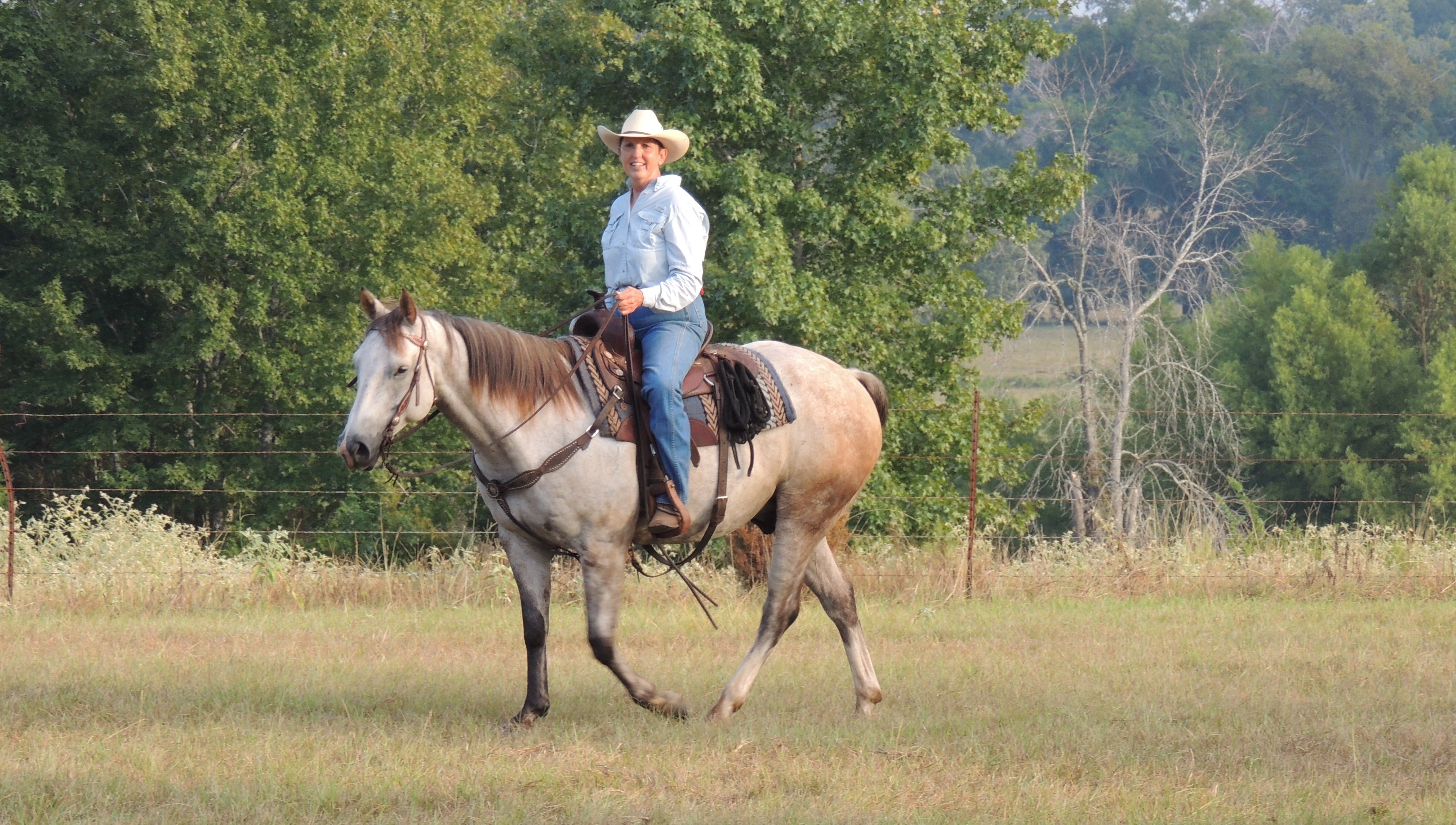
Very informative. It is scary how uninformed the general public is about their food.